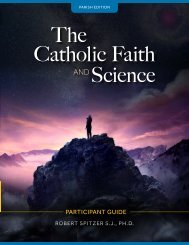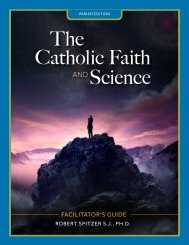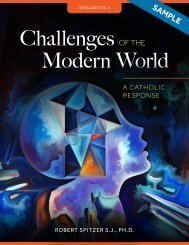Exploring Catholic Social Teaching
You also want an ePaper? Increase the reach of your titles
YUMPU automatically turns print PDFs into web optimized ePapers that Google loves.
LESSON PLAN<br />
DAY THREE<br />
Warm-Up<br />
A. Remind students that the purpose of government is to work for the common good. With that in<br />
mind, ask students to brainstorm a list of all the ways a government can do that. Keep a list on<br />
the board. Make sure to have a variety of actions, including very important tasks (protecting life,<br />
avoiding war), and less important ones (providing snow removal, or checking parking meters).<br />
B. After the list begins to take up most of the board, ask students how we can know which of these<br />
things are more important. The answer is that, along with knowing them through our own<br />
reason, we can turn to the Church for guidance about what those most important things are.<br />
Activity<br />
A. Distribute and have students read Handout B: A Just Hierarchy of Values and answer the<br />
question at the end of Part I. Clarify any misunderstandings before proceeding to Part II.<br />
B. Have students work to complete Part II with a partner, and go over responses as a class.<br />
DAY FOUR<br />
Warm-Up<br />
A. Begin by recalling the question from the previous day’s reading: what happens when a manmade<br />
law conflicts with the natural law?<br />
B. Have students read the information at the top of Handout C: What Is Right vs. What Is Legal<br />
and have them complete the chart for their assigned individual(s).<br />
Activity<br />
A. After students have filled in their information, spend time comparing and contrasting the types<br />
of unjust laws each person faced, as well as the risk each person took in refusing to obey.<br />
B. As a class, discuss the question of whether people today seem to understand the real meaning<br />
of justice:<br />
ӹ<br />
What unjust laws in history can you recall? The Indian Removal Act (1830) forcing Native<br />
Americans from their land, the Fugitive Slave Act (1850) which required Northerners to return<br />
escaped slaves to their masters, Executive Order 9066 signed by FDR in 1942 forcing Japanese<br />
Americans into internment camps, and so forth.<br />
112<br />
© SOPHIA INSTITUTE FOR TEACHERS

















